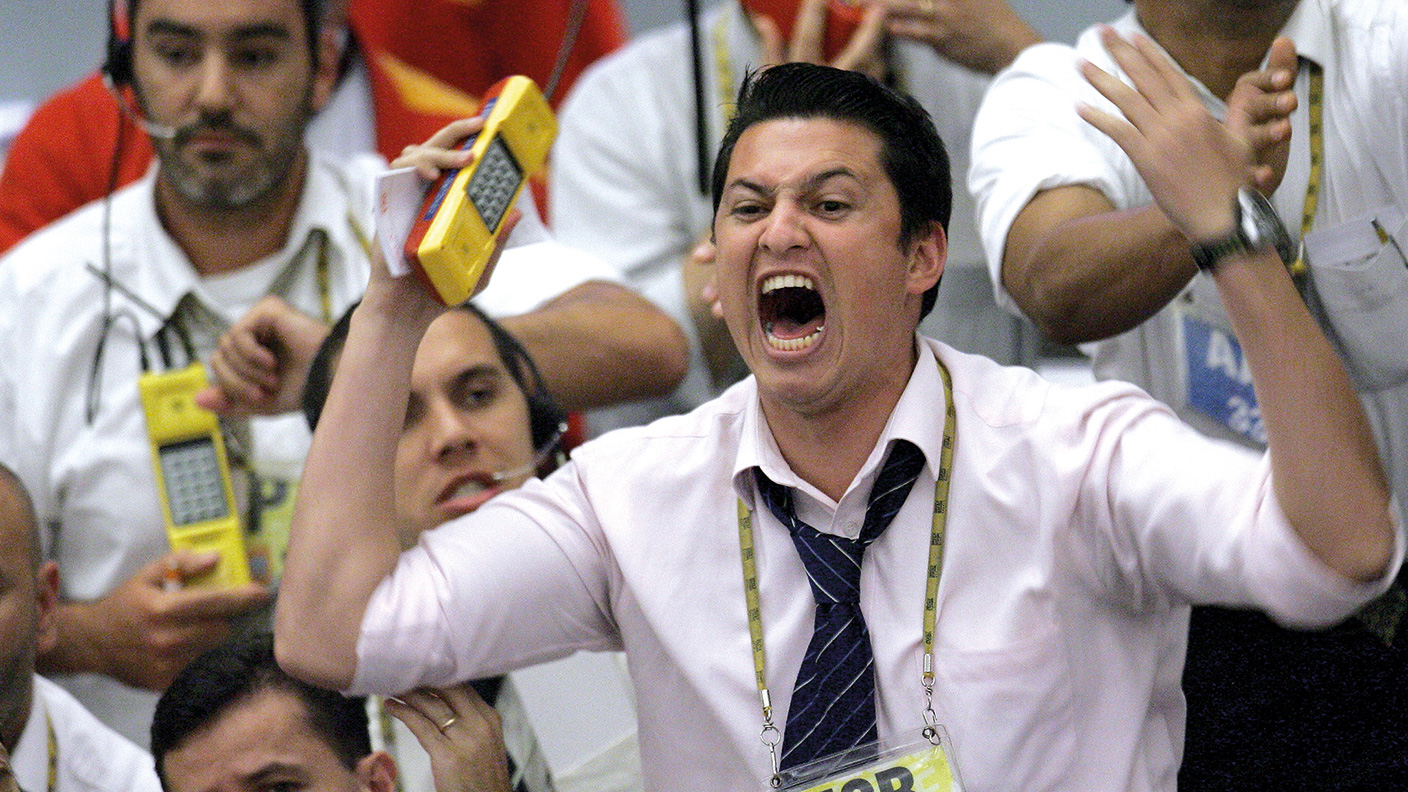Get the better of your biases when you trade stocks
There are eight key psychological pitfalls that can part inexperienced investors from their money. Michael Taylor explains what they are – and how you can overcome them

Trading is one of the most brutal pursuits on the planet. There is little risk of physical harm such as a broken appendage or being punched in the face, but psychologically it can be difficult and at times, even stressful. I’ve heard of traders who’ve put their entire house deposit into the market and lost it; some have squandered their life savings betting on a single stock.
Trading can be profitable, but it can also be cruel. Sometimes you can do everything right and still lose money. You can have an edge, but nothing is guaranteed. Still, there are many things that we can do to increase our chances of success. We can control our entries, our exits, our position-sizing, risk management, how well we actively manage and monitor the trade – and also our mindset and psychology.
The best traders are able to master themselves. Many people believe that brokers, market makers and other market participants are their competition. But it’s you who will break your own rules, lack discipline and succumb to the fear of missing out (Fomo). In this article, we look at eight of the most common trading biases and learn how to combat them.
MoneyWeek
Subscribe to MoneyWeek today and get your first six magazine issues absolutely FREE

Sign up to Money Morning
Don't miss the latest investment and personal finances news, market analysis, plus money-saving tips with our free twice-daily newsletter
Don't miss the latest investment and personal finances news, market analysis, plus money-saving tips with our free twice-daily newsletter
Loss aversion
Aversion to loss is potentially the most threatening cognitive bias. Loss aversion is the theory that we feel the pain of loss twice as much as we feel the pleasure of a gain. The theory was the result of work done by Daniel Kahneman and Amos Tversky, who are considered the fathers of behavioural economics (their work is well worth reading for anyone involved in financial markets).
Loss aversion comes into play because we don’t want to sell losing trades or positions lest we feel the pain of a loss. But here’s the rub: if the market has marked your merchandise down, you’ve already lost. A famous trading dictum posits that “it’s only a loss if you sell”. This is a fantasy. If it affects your net worth, it’s a real loss.
One way to beat loss aversion is by knowing your maximum risk before you place the trade and knowing when you’ll sell if the trade goes the wrong way (set a stop-loss). When the time comes, you simply follow your plan and get out. Another way to combat loss aversion is to take small positions. Bigger positions exaggerate our emotions, so the bigger the position, the more likely you are to be seduced by loss aversion and move your stop-loss further down. Before you know it, you can end up losing a lot more. Don’t take positions without knowing your downside and having a plan.
Gambler’s fallacy
Gambler’s fallacy is another common bias in new traders and investors. It occurs when a person believes that after a string of losing trades they are more likely to achieve success because they’re “due a winner”. Unfortunately, all trades are independent of each other. Just because you’ve lost ten trades in a row doesn’t mean you can’t lose another ten. In the same way, the odds of a coin landing on tails after hitting ten heads in a row is still 50%.
Gambler’s fallacy can often tempt people into sizing up in order to chase back losses because they feel they must now win. Never be tempted to size up when losing – this only increases your risk and raises the odds of making mistakes.
Attribution bias
Attribution bias describes a scenario in which traders ascribe success to themselves, but blame others when things go wrong. For example, after a losing trade a trader who has a heavy attribution bias may decide to blame their broker, the market, or their keyboard, even if they broke all their trading rules and it’s clearly their own fault.
Nobody likes to blame themselves, but this is a core tenet that characterises successful traders. Taking responsibility for your own decisions – even if the fault genuinely was not yours – is an excellent way to grow as a trader. Don’t fall into the trap of blaming others. Instead, consider what you could have done better.
Endowment bias
The endowment effect is when we believe that something we own is worth more purely by virtue of us owning it. Everyone believes their house is the nicest on the street. Whenever we buy a stock, we value it more highly than we would if we didn’t own it. That means we’re at our most objective when we don’t have a position. Therefore we should do our research and plan our trading before we take a position. Once we press buy, we lose our objectivity.
Bandwagon bias
The bandwagon effect makes it hard for us to go against the crowd. Warren Buffett once said in order to get rich you need to “sell when everyone is greedy and buy when everyone is fearful”. This is easier said than done. Everyone wants to buy the dip until there is a dip. Everyone wants to be a contrarian, but nobody wants to risk losses. Contrarians can look silly for long periods of time until they’re proved right – if they ever are.
In February 2020 when China shut down, I thought it was only a matter of time before Covid-19 reached other countries. Yet when Italy started going into lockdown the markets remained at all-time highs. It was as if the market had completely discounted the fact that we were heading straight into a global pandemic. I thought going short the indices and waiting for the market to react would be an excellent trade. If I was wrong, I could close the trade easily.
But I didn’t take the plunge. Why? Because the markets were at record highs. I thought that if the smartest minds in the world were dismissing the virus as nothing then they must be right. Everyone was bullish and I talked myself out of heavily shorting the market right before global stocks collapsed. It’s a lesson I cherish and one I’ll always remember. Sometimes you must stray from the crowd in order to outperform.
Recency bias
The recency bias is a cognitive bias whereby we put more weight on information and experiences that are more recent. For example, a chief financial officer leaving a company may cause some investors to sell. They believe it’s a red flag, but if you look at most companies this is merely noise over the longer term. Recency bias sees investors place more emphasis on the recent news, which ultimately has scant impact.
Traders can also fall victim to this bias. A trader with five losing trades in a row may decide that their strategy doesn’t work because it hasn’t worked the last five times. But this is simply variance. Traders can overcome this bias by tracking their results and maintaining belief in their edge: their tactical or strategic approach that they believe tips the odds in their favour over the long run. If you know your edge and have the discipline to follow it, then this should give you the confidence to keep going and avoid recency bias.
Confirmation bias
Confirmation bias is a classic bias. Everyone likes to be right and nobody likes to be wrong. But confirmation bias is dangerous to those who are unaware of it because we actively seek out information that tells us we’re right rather instead of looking at the opposing view. Those who are heavily influenced by confirmation bias can attack others who have a different opinion. This is because they are so emotionally invested that their opinion becomes a part of their identity. Bulletin boards are loaded with confirmation bias, with everyone singing from the same hymn sheet. Anyone asking about the downside or posting a negative view will be attacked and reported.
When I was a new trader, I was in a Twitter group full of shareholders in Cloudtag, a personal fitness-monitoring device maker. The product had been delayed twice and I started asking questions – only to be removed from the chat. I then realised this was a full-on bubble and sold my stock into strength, but sadly many shareholders are still holding shares that have been delisted from brokerage accounts even today.
Confirmation bias is dangerous because it can cloud your judgement. Even those who are aware of the bias aren’t immune to it. The best traders actively seek out the downside and what can go wrong on the trade because they know that they alone are responsible for their results . Next time you find yourself in a trade, ask yourself: “What is the person on the other side of my trade thinking?” Because there will be someone on the other side of your trade, and they might just be right.
Blind-spot bias
Blind-spot bias reflects the ease with which we can point out others’ mistakes and biases, but not see our own. This is because we’re detached from the situation and not bogged down in so many details. That allows us to assess how they’re going wrong. The problem with this is that we’re unable to spot these same mistakes in ourselves and therefore we leave ourselves wide open.
One way we can tackle this is to team up with another trader and swap ideas, notes and trades. Your trading journal should also give you enough quantitative and qualitative data to allow you to discern commonalities in where you’re going wrong. Most traders don’t keep a trading journal – but most traders don’t make money either.
Understanding and tackling these eight biases will greatly improve your trading. However, there are many biases and the onus is on you to keep improving your knowledge and manage your emotions effectively. For more information on biases, I’d recommend Thinking, Fast and Slow by Daniel Kahneman.
Michael’s monthly stock-trading newsletter Buy the Breakout is free from his website: shiftingshares.com/newsletter
Get the latest financial news, insights and expert analysis from our award-winning MoneyWeek team, to help you understand what really matters when it comes to your finances.
Michael Taylor is an ex-trader. For more from him, see shiftingshares.com.
-
 The war dividend – how to invest in defence stocks as the world arms up
The war dividend – how to invest in defence stocks as the world arms upWestern governments are back on a war footing. Investors should be prepared, too, says Jamie Ward
-
 Literacy Capital: A trust where great returns fund a good cause
Literacy Capital: A trust where great returns fund a good causeThere’s plenty to like about specialist private-equity trust Literacy Capital, says Max King
-
 An AI bust could hit private credit – could it cause a financial crisis?
An AI bust could hit private credit – could it cause a financial crisis?Opinion Private credit is playing a key role in funding data centres. It may be the first to take the hit if the AI boom ends, says Cris Sholto Heaton
-
 8 of the best ski chalets for sale now
8 of the best ski chalets for sale nowThe best ski chalets on the market – from a traditional Alpine-style chalet in Switzerland to an award-winning Modernist building in Japan’s exclusive ski areas
-
 Did COP30 achieve anything to tackle climate change?
Did COP30 achieve anything to tackle climate change?The COP30 summit was a failure. But the world is going green regardless, says Simon Wilson
-
 Who is Christopher Harborne, crypto billionaire and Reform UK’s new mega-donor?
Who is Christopher Harborne, crypto billionaire and Reform UK’s new mega-donor?Christopher Harborne came into the spotlight when it emerged he had given £9 million to Nigel Farage's Reform UK. How did he make his millions?
-
 The best Christmas gifts for your loved ones
The best Christmas gifts for your loved onesWe round up the best Christmas gifts with a touch of luxury to delight, surprise and amaze family and friends this festive season
-
 Leading European companies offer long-term growth prospects
Leading European companies offer long-term growth prospectsOpinion Alexander Darwall, lead portfolio manager, European Opportunities Trust, picks three European companies where he'd put his money